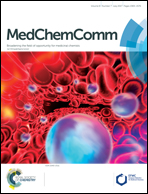Synthesis and pharmacological evaluation of multi-functional homoisoflavonoid derivatives as potent inhibitors of monoamine oxidase B and cholinesterase for the treatment of Alzheimer's disease†‡
Abstract
A series of homoisoflavonoid derivatives was designed, synthesized and evaluated as potential multi-functional anti-Alzheimer's agents for their inhibitory activity on cholinesterase and monoamine oxidase. Among them, compound 16 showed moderate acetylcholinesterase (AChE) inhibitory activity (eeAChE IC50 = 0.89 ± 0.02 μM; hAChE IC50 = 0.657 ± 0.002 μM) and significant monoamine oxidase B (MAO-B) inhibitory activity (hMAO-B IC50 = 0.0372 ± 0.0002 μM). Kinetic analysis of AChE, MAO-B inhibition and molecular modeling studies revealed that compound 16 is a dual binding site inhibitor of AChE and noncompetitive inhibitor of MAO-B. Furthermore, 16 could penetrate through the blood–brain barrier (BBB) in vitro. Most importantly, oral administration of 16 demonstrated no marked signs of acute toxicity and it could significantly reverse scopolamine-induced memory impairment in mice. These results suggested that compound 16 is a promising multifunctional drug candidate with potential effect for the treatment of Alzheimer's disease.



 Please wait while we load your content...
Please wait while we load your content...